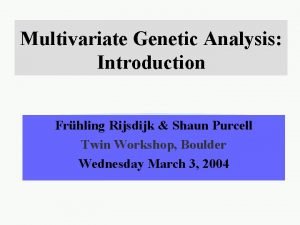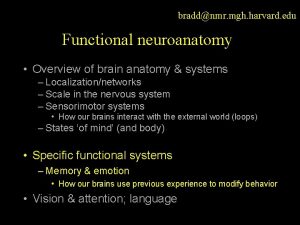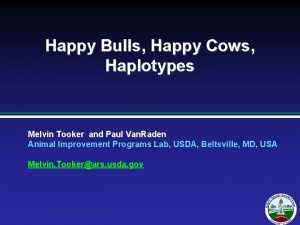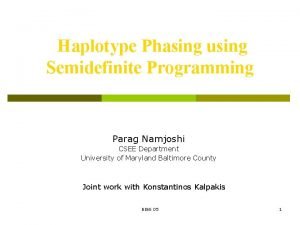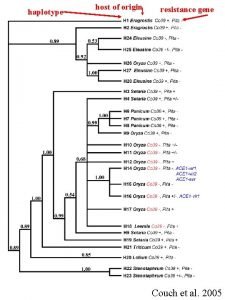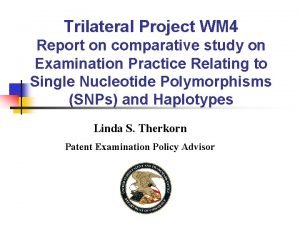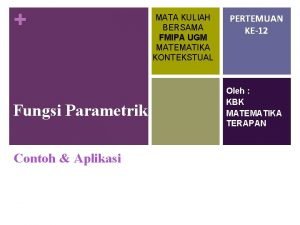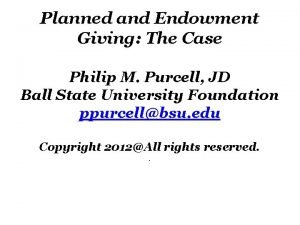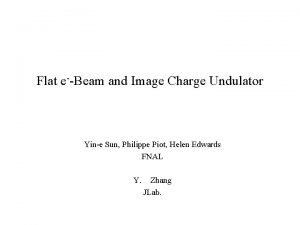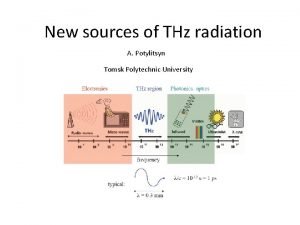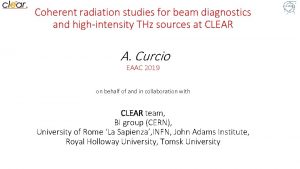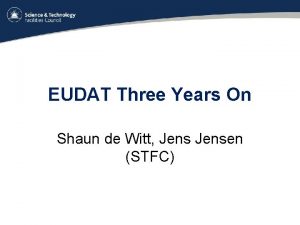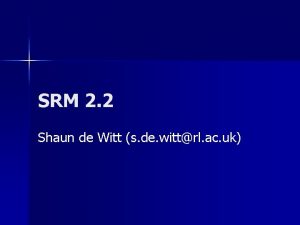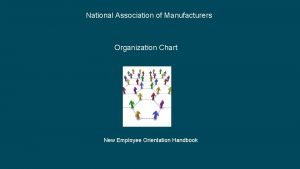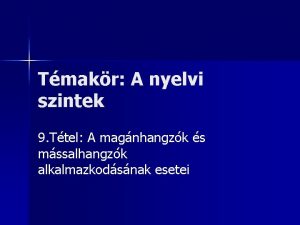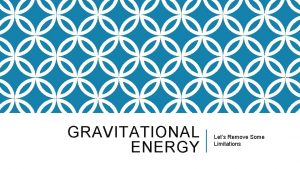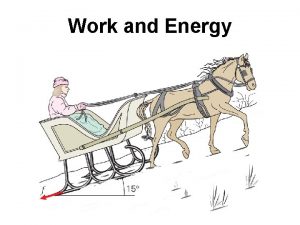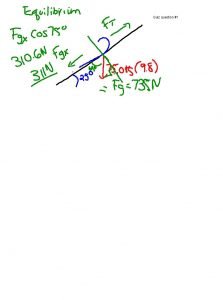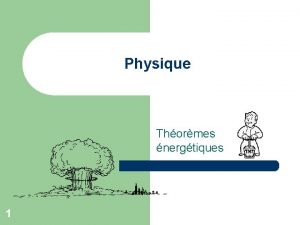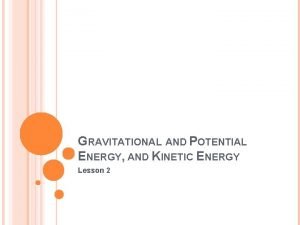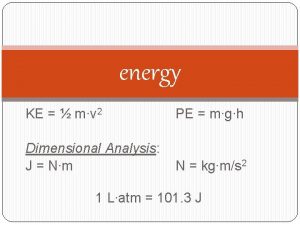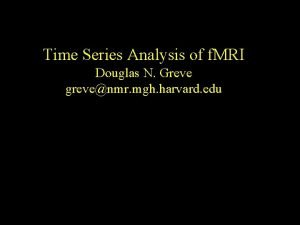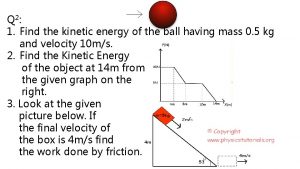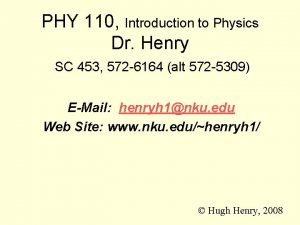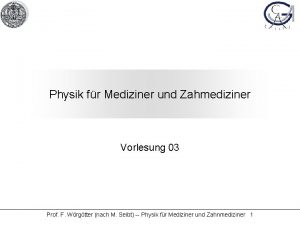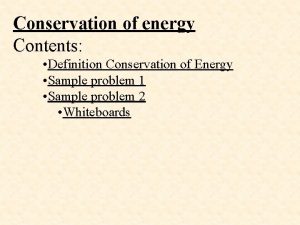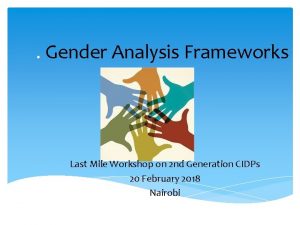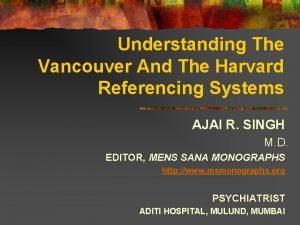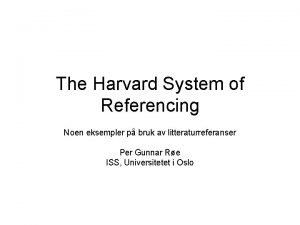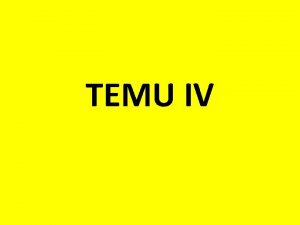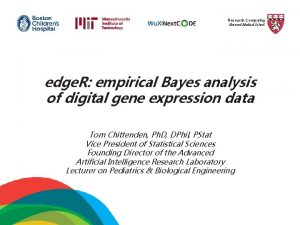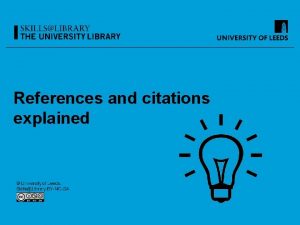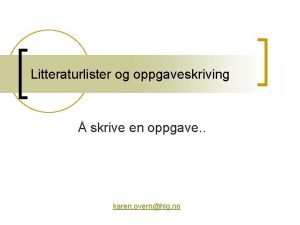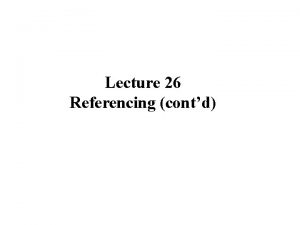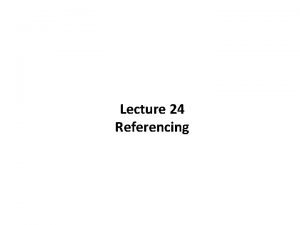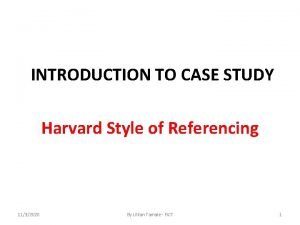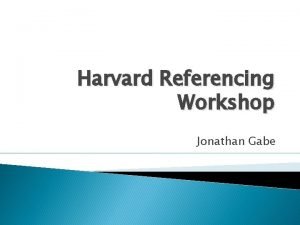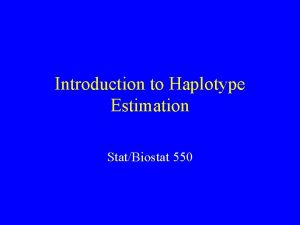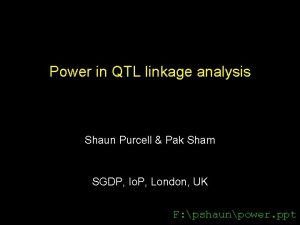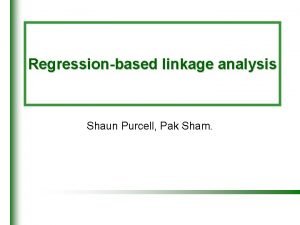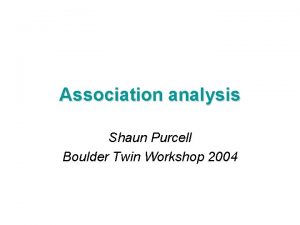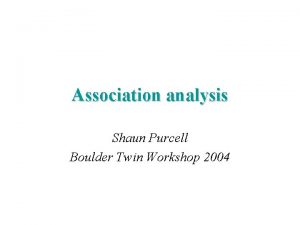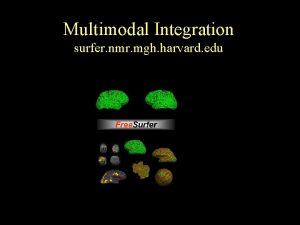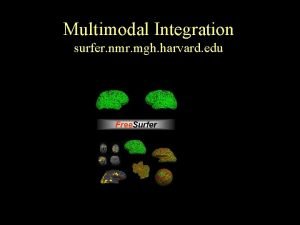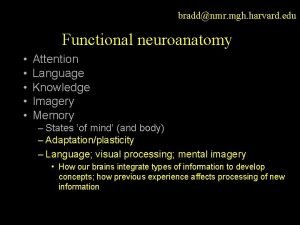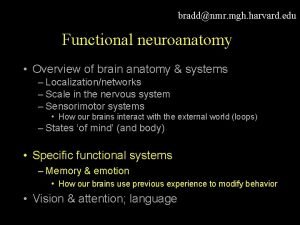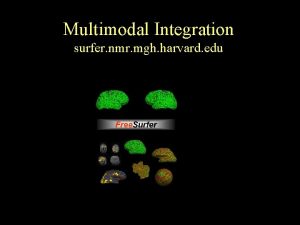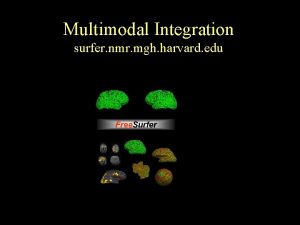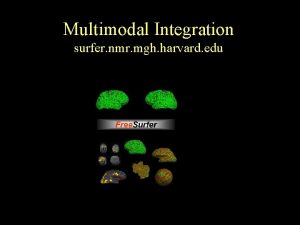Haplotype analysis Shaun Purcell shaunpngu mgh harvard edu



















































































- Slides: 83

Haplotype analysis Shaun Purcell shaun@pngu. mgh. harvard. edu MGH, Boston

Haplotypes A M m a a. M am This individual has aa and Mm genotypes and am and a. M haplotypes

A M m a AM Am This individual has AA and Mm genotypes and AM and Am haplotypes

A M m a AM am This individual has Aa and Mm genotype and AM and am haplotypes…

A M m a AM am This individual has Aa and Mm genotype and AM and am haplotypes… given only genotype data, consistent with Am/a. M as well as AM/am but

Haplotype analysis 1. Estimate haplotypes from genotypes 2. Associate haplotypes with trait Haplotype AAGG AAGT CGCG AGCT Freq. 40% 30% 25% 5% Odds Ratio 1. 00* 2. 21 1. 07 0. 92 * baseline, fixed to 1. 00

Measuring haplotypes Expectation – Maximisation algorithm Applicable in situations where there are more categories than can be distinguished i. e. ‘incomplete data problems’ Complete data = ( Observed data , Missing data ) Haplotype data = ( Genotype data , Phase data )

Measuring haplotypes Genotypes Haplotypes A/A B/b C/c ABC / Abc or ABc / Ab. C Phases

E-M algorithm 1. Guess haplotype frequencies 2. (E) Use those frequencies to replace ambiguous genotypes with fractional haplotype counts 3. (M) Estimate frequency of each haplotype by counting 4. Repeat (2) and (3) until convergence

Dataset to be phased 4 individuals genotyped for 2 diallelic markers ID 1 ID 2 ID 3 ID 4 A/A A/a a/a B/B b/b B/b b/b

Dataset to be phased 4 individuals genotyped for 2 diallelic markers ID 1 ID 2 ID 3 ID 4 A/A A/a a/a B/B b/b B/b b/b AB / AB Ab / ab AB / ab ? Ab / a. B ab / ab

E-step Replace ambiguous A/a B/b genotype with : AB / ab : Ab / a. B :

E-step PAB = 0. 25 Pa. B = 0. 25 PAb = 0. 25 Pab = 0. 25 Replace ambiguous A/a B/b genotype with : AB / ab : 2 × PAB × Pab Ab / a. B : 2 × PAb × Pa. B

E-step PAB = 0. 25 Pa. B = 0. 25 PAb = 0. 25 Pab = 0. 25 Replace ambiguous A/a B/b genotype with : AB / ab : 2 × PAB × Pab = 2 × 0. 25 = 0. 125/(0. 125+0. 125) = 0. 50 Ab / a. B : 2 × PAb × Pa. B = 2 × 0. 25 = 0. 125/(0. 125+0. 125) = 0. 50

E-step Incomplete data A/A B/B Complete data AB / AB Count 1. 00 A/a b/b Ab / ab 1. 00 A/a B/b AB / ab Ab / a. B 0. 50 a/a b/b ab / ab 1. 00

M-step Incomplete data A/A B/B Complete data AB / AB Count 1. 00 A/a b/b Ab / ab 1. 00 A/a B/b AB / ab Ab / a. B 0. 50 a/a b/b ab / ab 1. 00 Counting AB haplotype = 2 × 1 + 1 × 0. 5 = 2. 5

M-step Incomplete data A/A B/B Complete data AB / AB Count 1. 00 A/a b/b Ab / ab 1. 00 A/a B/b AB / ab Ab / a. B 0. 50 a/a b/b ab / ab 1. 00 Counting a. B haplotype = 1 × 0. 5 = 0. 5

M-step Incomplete data A/A B/B Complete data AB / AB Count 1. 00 A/a b/b Ab / ab 1. 00 A/a B/b AB / ab Ab / a. B 0. 50 a/a b/b ab / ab 1. 00 Counting Ab haplotype = 1 × 1 + 1 × 0. 5 = 1. 5

M-step Incomplete data A/A B/B Complete data AB / AB Count 1. 00 A/a b/b Ab / ab 1. 00 A/a B/b AB / ab Ab / a. B 0. 50 a/a b/b ab / ab 1. 00 Counting ab haplotype = 1 × 1 + 1 × 0. 5 + 2 × 1 = 3. 5

M-step Haplotype counts, frequencies from complete data AB a. B Ab ab Sum Count 2. 5 0. 5 1. 5 3. 5 8. 0 Freq 0. 3125 0. 0625 0. 1875 0. 4375 1. 0000

back to the E-step…. PAB = 0. 25 Pa. B = 0. 25 PAb = 0. 25 Pab = 0. 25 are now replaced with the updated estimates PAB = 0. 3125 Pa. B = 0. 0625 PAb = 0. 1875 Pab = 0. 4375

back to the E-step…. PAB = 0. 25 Pa. B = 0. 25 PAb = 0. 25 Pab = 0. 25 are now replaced with the updated estimates PAB = 0. 3125 Pa. B = 0. 0625 PAb = 0. 1875 Pab = 0. 4375 Replace ambiguous A/a B/b genotype with : AB / ab : 2 × PAB × Pab = 2 × 0. 3125 × 0. 4375 = 0. 273/(0. 273+0. 023) = 0. 92 Ab / a. B : 2 × PAb × Pa. B = 2 × 0. 1875 × 0. 0625 = 0. 023/(0. 273+0. 023) = 0. 08

back to the M-step… Incomplete data A/A B/B Complete data AB / AB Count 1. 00 A/a b/b Ab / ab 1. 00 A/a B/b AB / ab Ab / a. B 0. 92 0. 08 a/a b/b ab / ab 1. 00 Counting AB haplotype = 2 × 1 + 1 × 0. 92 = 2. 92

back to the M-step… Haplotype counts, frequencies from complete data AA a. B Ab ab Sum Count 2. 92 0. 08 1. 08 3. 92 8. 0 Freq 0. 365 0. 010 0. 135 0. 490 1. 0000

and back, again, to the E-step… and back, again, to the M-step… ……

Haplotype frequency estimates AB i 0 0. 250 i 1 0. 315 i 2 0. 365 …… … i. N 0. 375 a. B Ab ab 0. 250 0. 0625 0. 1875 0. 010 0. 135 … … 0. 000 0. 125 0. 250 0. 4375. 0. 490 0. 500

Posterior probabilities Bayes Rule

Posterior Probabilities Example: Genotype Aa. Bb Haplotype frequencies AB 0. 375 a. B 0 Ab 0. 125 ab 0. 5

Posterior probabilities Genotype Phase P(H|G) A/A B/B AB / AB 1. 00 A/a b/b Ab / ab 1. 00 A/a B/b AB / ab Ab / a. B 1. 00 0. 00 a/a b/b ab / ab 1. 00

Missing genotype data A/A 0/0 c/c consistent with 3 phases Phase ABc / Abc / Abc P(H|G) ( PABc × PABc ) / S ( 2 × PABc × PAbc ) / S ( PAbc × PAbc ) / S where S = PABc × PABc + 2 × PABc × PAbc + PAbc × PAbc

Using parental genotypes Can often help to resolve phase A/a B/b C/c

Using parental genotypes Can often help to resolve phase A/A B/B C/c a/a b/b c/c A/a B/b C/c

Using parental genotypes Can often help to resolve phase A/A B/B C/c a/a b/b c/c A/a B/b C/c ABC / abc

Using parental genotypes Can often help to resolve phase A/A B/B C/c a/a b/b c/c A/a B/b C/c ABC / abc … but not always A/a B/b C/c A/a B/b c/c A/a B/b C/c

A (slightly) less trivial example 1 11 12 12 ? 2 12 11 12 ? 3 22 11 12 211 / 212 4 12 12 11 ? 5 12 11 12 ? 6 11 22 22 122 / 122 7 12 11 22 112 / 212 8 22 11 11 211 / 211 9 12 12 22 ? 10 22 222 / 222

haplotype frequencies Estimated haplotype frequency E-M iteration

log-likelihood

Haplotype frequencies H P(H) 211 0. 299996 112 0. 235391 222 0. 135402 122 0. 114604 212 0. 114602 121 0. 099994 111 0. 000010 221 0. 000000

ID 1 1 1 2 chr 111 122 112 121 Hap P(H|G) 0. 0001234 0. 9998766 2 2 1 2 111 212 112 211 0. 0000411 0. 9999589 3 3 1 2 211 212 1. 0000000 4 4 1 2 111 221 121 211 0. 0000000 1. 0000000 5 5 1 2 111 212 112 211 0. 0000411 0. 9999589 ID chr Hap P(H|G) 6 6 1 2 122 1. 0000000 7 7 1 2 112 212 1. 0000000 8 8 1 2 211 1. 0000000 9 9 1 2 112 222 122 212 0. 7080343 0. 2919657 10 10 1 2 222 1. 0000000

But it's not always this easy. . . For m SNPs there are… 2 m possible haplotypes 2 m-1 (2 m+1) possible haplotype pairs For m = 10 then 1, 024 possible haplotypes 524, 800 possible haplotype pairs

Haplotype analysis software Many available packages: EH+/Genecouting (Zhao) Haplo. View (Barrett) PHASE (Stephens) FBAT/HBAT/PBAT (Xu et al, Lange) haplo. score (Schaid) e. Hap (Roeder) / ET-TDT (Seltman) UNPHASED (Dudbridge) PLINK (Purcell et al) whap (Purcell & Sham)

whap Numerous recent methods using GLM approach Schaid et al (02) AJHG Zaykin et al (02) Hum Hered Quantitative and qualitative traits Mixture of regressions framework Between/within family model Model either L(X|G) or L(G|X) Covariates and moderators Flexible specification of nested submodels

Two main types of test Haplotype-specific tests H tests each with 1 df compare each haplotype versus all others correction for multiple tests not built-in Omnibus test single test with H-1 df compare each haplotype against an (arbitrary) reference haplotype built-in correction for multiple tests ACCGAGACTA versus ACCACTGTGC GCTGAGGCGC ATTGAGATGA b 1 ACCGAGACTA ACCACTGTGC GCTGAGGCGC ATTGAGATGA 0 b 1 b 2 b 3 0

Covering large genomic areas Exhaustive haplotype approach (ETDT) Sliding window of fixed size (whap) Haplotype-specific block-based tests (Haplo. View) Specific small multimarker predictors of known, common but otherwise untagged variants (Haplo. View, plink)

For full details: http: //pngu. mgh. harvard. edu/purcell/whap/ File formats Similar to QTDT/Merlin input format data. ped 1 1 0 0 1 -9 12 AA 1 2 0 0 2 -9 22 CC 1 3 1 2 1 -0. 23 1 2 A C Example T quant 1 M rs 000002 data. map 14 rs 000001 14 rs 000002 0 123232 0 123887 command lines whap --file data --alt 5, 6, 7 --null 5, 7 whap --file data --alt 1, 2, 3 --at 5 --sec --perm 5000 whap --file data --alt 1, 2 --window --cond --prev 0. 02 --model w --wperm 5000

Omnibus test whap --file data --alt 5, 6, 7, 8, 9, 10, 11 --at 2 300 individuals w/out parents. 0 individuals with parents. 275 of 300 individuals are informative Hap --2122221 2112121 2221211 22122222 1112121 2222221 2212221 --- Freq ----0. 313 0. 169 0. 122 0. 115 0. 112 0. 099 0. 041 0. 029 ----- Alt(B) -----0. 000 -0. 249 -0. 417 -0. 419 0. 044 -0. 213 0. 115 -0. 662 Alt(W) -----0. 000 -0. 249 -0. 417 -0. 419 0. 044 -0. 213 0. 115 -0. 662 -----766. 078 Proportion of haplotypes covered = 0. 955 LRT = 21. 595 df = 7 p = 0. 00298 [1] [2] [3] [4] [5] [6] [7] [8] Null(B) ------0. 000 0. 000 Null(W) ------0. 000 0. 000 ------787. 673 [1] [1]

Haplotype-specific tests whap --file data --alt 1, 2, 3 --at 2 Haplotype Freq 1 2 3 4 0. 525 0. 220 0. 180 0. 075 AGC CGA ATA B & W coeffs -0. 472 0. 107 -0. 088 0. 116 --hs Chi-sq 8. 546 0. 428 0. 265 0. 381 p 0. 00346 0. 513 0. 606 0. 537

Practical sessions Analysis of simulated data Detecting haplotype association using whap Fitting nested model to explore the association using whap

Practical: Simulated data. ACGT. ped 1_A 1 0 0 1 2_A 1 0 0 1. . . 1_B 1 0 0 1. . . data. ACGT. dat A M M M disease snp 1 snp 2 snp 3 snp 4 snp 5 2 2 A A C C A C A G G T G C C A C 1 C C C G G A A data. ACGT. map 1 1 1 snp 2 snp 3 snp 4 snp 5 0 0 0 1 2 3 4 5 If pedstats program available, you can check the datafile with: pedstats -p data 1234. ped -d data 1234. dat

Practical: the true model General population haplotype frequencies ACAGC CCCGA AAATA AACTA ACCGC 0. 25 0. 20 0. 05 Increases risk for disease

Practical Use whap to phase data. ACGT. ped whap --file data. ACGT --phase Just print out phases whap --file data. ACGT --phase > probs. txt. . . or send to a file Single SNP analysis Haplotype analysis Analyse 1 st SNP whap --file data. ACGT --alt 1 Analyse 5 th SNP whap --file data. ACGT --alt 5 whap --file data. ACGT --window --perm 50 Sliding window + empirical p-values whap --file data. ACGT Omnibus test whap --file data. ACGT --alt 1, 2, 3, 4, 5 As above whap --file data. ACGT --hs All haplotype-specific tests

Performance of phasing Of 400 individuals, 16 could not be assigned phase with (near) certainty: all 16 had the same genotypes: AA AC AC GT AC AAATA / ACCGC 0. 324 1_A 2_A 3_A 4_A 5_A 6_A 7_A 8_A 9_A. . . 1 1 1 AACTA / ACAGC 0. 676 1 1 2 1 1 1 1 ACCGC AACTA AAATA ACAGC ACCGC ACAGC AAATA CCCGC ACAGC ACCGC AAATA AACTA AAATA ACAGC CCCGC ACAGC 1. 000 0. 676 0. 324 1. 000

Single SNP analysis whap --file data. ACGT --window --perm 500 Global permutation tests ------------P_MAX = 6. 791 p = 0. 0279 P_SUM = 21. 618 p = 0. 0119 Local permutation tests ----------->> snp 1 1 P_1= 0. 019 >> snp 2 2 P_2= 6. 791 >> snp 3 3 P_3= 4. 412 >> snp 4 4 P_4= 6. 791 >> snp 5 5 P_5= 3. 605 p= p= p= Empirical p-values, corrected for multiple testing 0. 8822 0. 0119 0. 0199 0. 0119 0. 0518

Omnibus test whap --file data. ACGT --alt 1, 2, 3, 4, 5 WHAP! | v 2. 04 | 05/09/03 | S. Purcell, P. Sham | purcell@wi. mit. edu 400 individuals w/out parents. 0 individuals with parents. Binary trait: 400 of 400 individuals/trios are informative Hap Freq Alt(B) Alt(W) --------ACAGC 0. 264 0. 000 [1] CCCGC 0. 237 0. 406 [2] CCCGA 0. 212 0. 269 [3] AAATA 0. 169 0. 383 [4] AACTA 0. 067 1. 338 [5] ACCGC 0. 050 0. 424 [6] ------535. 439 Proportion of haplotypes covered = 1. 000 LRT = 19. 079 df = 5 p = 0. 00186 Null(B) ------0. 000 Null(W) ------0. 000 ------554. 518 [1] [1] [1]

Haplotype-specific tests whap --file data. ACGT --hs Haplotype Chi-sq(1 df) p-value beta OR ACAGC CCCGA AAATA AACTA ACCGC 8. 546 0. 428 0. 265 0. 381 13. 929 0. 073 -0. 472 0. 107 -0. 088 0. 116 1. 128 0. 092 0. 62 1. 11 0. 91 1. 23 3. 08 1. 09 0. 00346 0. 513 0. 607 0. 537 0. 00019 0. 787

Haplotype-specific tests whap --file data. ACGT --hs Haplotype Chi-sq(1 df) p-value beta OR ACAGC CCCGA AAATA AACTA ACCGC 8. 546 0. 428 0. 265 0. 381 13. 929 0. 073 -0. 472 0. 107 -0. 088 0. 116 1. 128 0. 092 0. 62 1. 11 0. 91 1. 23 3. 08 1. 09 0. 00346 0. 513 0. 607 0. 537 0. 00019 0. 787 From logistic regression OR is calculated by e^(Beta), where e is 2. 71828459….

Average test statistic Haplotype-specific or omnibus? Largest haplotype-specific test (empirical p-value to correct for multiple testing) Omnibus test

Detection of associations Detection test single SNP haplotype-specific omnibus test “Is X associated with my phenotype? ” where X is either an allele, genotype, haplotype or set of haplotypes

Dissection of an association Assuming a haplotypic association, explores the nature of the association, e. g. single or multiple haplotype effects? a single SNP explains the entire effect? “Is X associated with my phenotype independent of Y? ”

Interpreting effects True model 1 AACG 2 GGAC 3 AAAC 90% 05% 2 v. s. 3 v. s. 1 1 v. s. 2 3 3 2 1 2 3 1 Looks like 1 AACG 2 GGAC 3 AAAC 90% 05% Haplotype-specific tests:

Interpreting effects True model 1 AACG 2 GGAC 3 AAAC 50% strong effect 40% 10% mild effect Under an omnibus test 1 AACG 2 GGAC 3 AAAC OR = 1. 0 OR = 0. 4 OR = 0. 9

Specifying the model in whap Specify markers to form haplotypes from under the alternate and null --alt 1, 2, 3, 4 1111 1122 2221 2222 2211 [1] [2] [3] [4] [5] --null 3, 4 1111 1122 2221 2222 2211 [1] [2] [3] [2] [1]

Specifying the model in whap Equate haplotypes directly --constrain 1, 2, 3, 4, 5/1, 2, 3, 2, 1 1111 1122 2221 2222 2211 [1] [2] [3] [4] [5] 1111 1122 2221 2222 2211 [1] [2] [3] [2] [1] Note: first haplotype always has to have parameter [1] Must specify as many parameters as there are haplotypes

Conditional tests Two SNPs both individually predict the phenotype Do they have independent effects? Or can one explain the other? Haplotype AB ab Ab Freq 0. 50 0. 45 0. 05 Odds ratio 1. 00 (fixed) 2. 00 ? Alt [1] [2] [3] Null [1] [2] --alt 1, 2 --null 2

Conditional tests Does X have any effect after controlling for everything else? X independently contributes (if signif. ) X could be a SNP or set of SNPs --alt 1, 2, 3, 4, 5 --null 2, 3, 4, 5 “independent effect test” Does everything else still have any effect after controlling for X ? is necessary and sufficient (if test n. signif. ) X could be a SNP, set of SNPs, haplotype or set of haplotypes --alt 1, 2, 3, 4, 5 --null 1 --constrain 1, 2, 3, 4, 5, 6/1, 2, 1, 1 “sole variant test”

Haplotype-specific test (H 1) --constrain 1, 2, 2, 2 / 1, 1, 1, 1 A A A T A A C A G C C C C G A C C C G C A A C T A A C C G C

Haplotype-specific test (H 2) --constrain 1, 2, 1, 1 / 1, 1, 1, 1 A A A T A A C A G C C C C G A C C C G C A A C T A A C C G C

Omnibus test (df=5) --constrain 1, 2, 3, 4, 5, 6 / 1, 1, 1, 1 A A A T A A C A G C C C C G A C C C G C A A C T A A C C G C

Clade-based homogeneity test (1 df) --constrain 1, 1, 2, 2, 3, 3 / 1, 1, 2, 2 A A A T A A C A G C C C C G A C C C G C A A C T A A C C G C

Single SNP test (2 nd marker) --alt 2 A A A T A A C A G C C C C G A C C C G C A A C T A A C C G C

Independent effect test for SNP 1 --alt 1, 2, 3, 4, 5 --null 2, 3, 4, 5 A A A T A A C A G C C C C G A C C C G C A A C T A A C C G C

Independent effect test for SNPs 1, 2 and 3 --alt 1, 2, 3, 4, 5 A A A T A A C A G C C C C G A C C C G C A A C T A A C C G C --null 4, 5

Sole-variant test for 2 nd SNP --alt 1, 2, 3, 4, 5 A A A T A A C A G C C C C G A C C C G C A A C T A A C C G C --null 2

Sole-variant test for haplotype 2 --constrain 1, 2, 3, 4, 5, 6 / 1, 2, 1, 1 A A A T A A C A G C C C C G A C C C G C A A C T A A C C G C

Practical exercise Now continue practical session: “SECOND PART: DISSECTING THE EFFECT” Perform What conditional tests do these suggest about the nature of the association?

Standard SNP test (df=1) (chi-sq, p-value) SNP 1 0. 019 0. 89 SNP 2 6. 791 0. 00916 SNP 3 4. 412 0. 0357 SNP 4 6. 791 0. 00916 SNP 5 3. 605 0. 0576 --alt 1 Independent effect test (df=1) (chi-sq, p-value) SNP 1 0. 003 0. 959 SNP 2 n/a SNP 3 8. 954 0. 0114 SNP 4 n/a SNP 5 0. 408 0. 523 --alt 1, 2, 3, 4, 5 --null 2, 3, 4, 5 Sole-variant test (df=4) (chi-sq, p-value) SNP 1 19. 060 0. 000765 SNP 2 12. 288 0. 0153 SNP 3 14. 667 0. 00544 SNP 4 12. 289 0. 0153 SNP 5 15. 474 0. 00381 --alt 1, 2, 3, 4, 5 --null 1

Sole-variant tests for haplotypes Standard haplotype-specific tests Haplotype ACAGC CCCGA AAATA AACTA ACCGC Chi-sq(1 df) 8. 546 0. 428 0. 265 0. 381 13. 929 0. 073 p-value 0. 00346 0. 513 0. 607 0. 537 0. 00019 0. 787 1, 2, 2, 2 1, 2, 1, 1, 2, 1, 1, 1, 1, 2, 1 1, 1, 1, 2 / / / 1, 1, 1, 1, 1, 1 1, 1, 1, 1 1, 2, 3, 4, 5, 6 1, 2, 3, 4, 5, 6 / / / 1, 2, 2, 2 1, 2, 1, 1, 2, 1, 1, 1, 1, 2, 1 1, 1, 1, 2 Sole-variant tests for haplotypes Haplotype ACAGC CCCGA AAATA AACTA ACCGC Chi-sq(4 df) 10. 533 18. 651 18. 814 18. 698 5. 150 19. 006 p-value 0. 0323 0. 00092 0. 000855 0. 000901 0. 272 0. 000784

Including the causal variant AC-C-AGC CC-C-CGA AA-C-ATA AA-T-CTA AC-C-CGC Files cv. ACGT. * cv 1234. * 1_A 2_A 3_A 4_A 5_A 6_A 1 1 1 0 0 0 A M M M disease snp 1 snp 2 snp 3 snp 4 snp 5 cv 1 1 1 snp 2 cv snp 3 snp 4 snp 5 0 0 0 1 2 3 4 5 6 1 1 1 2 2 2 A A A C A C C A A A C C C A A A A C C A G T G G T T T G C A C C A A A C C T C C C C T T C

Single locus test of the CV whap --file data-cv --alt 3 WHAP! | v 2. 04 | 05/09/03 | S. Purcell, P. Sham | purcell@wi. mit. edu 400 individuals w/out parents. 0 individuals with parents. Binary trait: 400 of 400 individuals/trios are informative Hap Freq Alt(B) Alt(W) --------C 0. 935 0. 000 [1] T 0. 065 1. 064 [2] ------541. 518 Proportion of haplotypes covered = 1. 000 LRT = 13. 000 df = 1 p = 0. 000311 Null(B) ------0. 000 Null(W) ------0. 000 [1] ------554. 518 exp(1. 064) ~ OR 2. 9

Omnibus test with CV included whap --file sim-cv --alt 1, 2, 3, 4, 5, 6 WHAP! | v 2. 04 | 05/09/03 | S. Purcell, P. Sham | purcell@wi. mit. edu 400 individuals w/out parents. 0 individuals with parents. Binary trait: 400 of 400 individuals/trios are informative Hap Freq Alt(B) Alt(W) --------ACCAGC 0. 261 0. 000 [1] CCCCGC 0. 237 0. 411 [2] CCCCGA 0. 212 0. 276 [3] AACATA 0. 171 0. 406 [4] AATCTA 0. 065 1. 317 [5] ACCCGC 0. 052 0. 482 [6] ------535. 616 Proportion of haplotypes covered = 1. 000 LRT = 18. 901 df = 5 p = 0. 00201 Null(B) ------0. 000 Null(W) ------0. 000 ------554. 518 [1] [1] [1]

Sole-variant SNP tests SNP 1 SNP 2 CV SNP 3 SNP 4 SNP 5 --alt 1, 2, 3, 4, 5, 6 --alt 1, 2, 3, 4, 5, 6 --null 1 --null 2 --null 3 --null 4 --null 5 --null 6 LRT = 18. 882 LRT = 12. 111 LRT = 5. 901 LRT = 14. 489 LRT = 12. 111 LRT = 15. 296 df df df =4 =4 =4 p = 0. 000829 p = 0. 0165 p = 0. 207 p = 0. 0295 p = 0. 0165 p = 0. 00413

Sole-variant test of the CV whap --file cv. ACGT --alt 1, 2, 3, 4, 5, 6 --null 3 WHAP! | v 2. 06 | 13/Dec/04 | S. Purcell, P. Sham | spurcell@pngu. mgh. harvard. edu 400 individuals w/out parents. 0 individuals with parents. Binary trait: 400 of 400 individuals/trios are informative Hap Freq Alt(B) Alt(W) --------ACCAGC 0. 261 0. 000 [1] CCCCGC 0. 237 0. 412 [2] CCCCGA 0. 212 0. 276 [3] AACATA 0. 171 0. 406 [4] AATCTA 0. 065 1. 317 [5] ACCCGC 0. 052 0. 483 [6] ------535. 616 Proportion of haplotypes covered = 1. 000 LRT = 5. 901 df = 4 p = 0. 207 Null(B) ------0. 000 1. 065 0. 000 Null(W) ------0. 000 1. 065 0. 000 ------541. 518 [1] [1] [2] [1]

Single SNP vs “sole-variant” Standard SNP test SNP 1 SNP 2 CV SNP 3 SNP 4 SNP 5 SNP 1 SNP 2 “Sole-variant” test CV SNP 3 SNP 4 SNP 5
 Shaun purcell
Shaun purcell Mgh.harvard.edu
Mgh.harvard.edu Haplotype example
Haplotype example Haplotype
Haplotype Haplotype
Haplotype Haplotype
Haplotype Haplotype
Haplotype Moonrise by jenette purcell
Moonrise by jenette purcell Victoria purcell gates
Victoria purcell gates Find the local tax deducted: $456 biweekly, 2 1/2 % tax.
Find the local tax deducted: $456 biweekly, 2 1/2 % tax. Episikloida
Episikloida Stephen purcell
Stephen purcell Phil purcell planned giving
Phil purcell planned giving Zhang et al
Zhang et al Smith purcell radiation
Smith purcell radiation Smith purcell radiation
Smith purcell radiation Case analysis coach harvard pdf
Case analysis coach harvard pdf Shaun de witt
Shaun de witt Shaun dewitt
Shaun dewitt Shaun white diabetes
Shaun white diabetes Shaun tan biography
Shaun tan biography Shaun keihn
Shaun keihn Shaun topham
Shaun topham Shaun moss
Shaun moss Shaun loke
Shaun loke Shaun harris lse
Shaun harris lse Edu.sharif.edu
Edu.sharif.edu Ajakhangok
Ajakhangok Eg=mgh
Eg=mgh Gpe=mgh example
Gpe=mgh example Electric potential energy
Electric potential energy Si units of work
Si units of work Epg = m.g.h
Epg = m.g.h Mgh haven
Mgh haven Eric rosenberg md
Eric rosenberg md Clue cells
Clue cells Unidades del trabajo
Unidades del trabajo Ep= mgh
Ep= mgh Eg=mgh
Eg=mgh Dimension of p.e=mgh
Dimension of p.e=mgh Mgh
Mgh Mgh
Mgh A 2200 kg vehicle traveling at 94 km/h
A 2200 kg vehicle traveling at 94 km/h Mgh formula
Mgh formula Force x distance
Force x distance Work energy theorem
Work energy theorem Mgh physik
Mgh physik Mgh = 1/2kx^2
Mgh = 1/2kx^2 Hbr swot
Hbr swot Lie of the land
Lie of the land Harvard zoom account
Harvard zoom account Beaufort scale
Beaufort scale Bibliografie harvard metode van verwysing
Bibliografie harvard metode van verwysing Jim kenney harvard pilgrim
Jim kenney harvard pilgrim Difference between vancouver and harvard referencing
Difference between vancouver and harvard referencing Lj wei
Lj wei Antti rousi
Antti rousi Harvard eksempler
Harvard eksempler Pustaka kaji
Pustaka kaji Research computing harvard
Research computing harvard Harvard anglia 2008
Harvard anglia 2008 Rgu harvard referencing
Rgu harvard referencing In-text referencing harvard
In-text referencing harvard Harvard gmas
Harvard gmas Harvard extension school course catalog
Harvard extension school course catalog Mmu harvard
Mmu harvard Harvard student agencies program
Harvard student agencies program Human resource planning steps
Human resource planning steps Homeless to harvard summary
Homeless to harvard summary Harvard litteraturliste
Harvard litteraturliste Harvard referencing lecture
Harvard referencing lecture Harvard number referencing
Harvard number referencing Arsitektur harvard adalah
Arsitektur harvard adalah Melanie northrop harvard
Melanie northrop harvard Harvard style case study
Harvard style case study Guest model of hrm
Guest model of hrm Harvard estr
Harvard estr Harvard web publishing
Harvard web publishing What was harvard named after
What was harvard named after Harvard study abroad programs
Harvard study abroad programs How to cite a website in harvard
How to cite a website in harvard Imperial harvard referencing
Imperial harvard referencing Bibliography harvard method
Bibliography harvard method Harvard library portal
Harvard library portal
